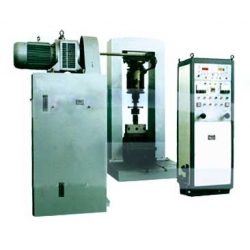
Product Description:
TR-TM-01 microcomputer screen display hydraulic pulsating fatigue testing machine is mainly used to conduct static compression tests and dynamic single-directional pulsating fatigue tests on various large components such as: bridges, truss, car chassis, front and rear axles, locomotive frame, chassis and concrete structural parts. This machine has significant features of reliable design, simple operation, energy conservation and low operating cost, etc.
After a comprehensive performance test, all kinds of actuators (50kN, 100kN, 250kN, 500kN) will be sent randomly or provided to customers to complete complex tests of multi-bit (more measurement points). They can also be used combined with any host to ensure accurate and stable values.
Technical Parameters:
1. Max. dynamic testing force: 500kN Max. static testing force: 500kN
2. Reading accuracy: ôÝ 1%
3. Working frequency range (stepless speed regulating): 2Hz-8Hz
4. Max. emission of pulsator t: 400ml / times
5. Counter: a word every 100 running times
6. 500kN actuator:
7. Max. amplitude: 15mm (two actuators work simultaneously)
8. Max. piston stroke: 120mm
9. Max. amount out of screw: 400mm
10. Length of extended tube: 400mm, 800mm full scale displaying value of control cabinet: 5000 full-scale displaying value of computer: 5000
11. Main motor power: about 11kW
12. Afterburner framework and tooling: according to usersã requirements
Technical Parameters:
1. Max. dynamic testing force: 500kN Max. static testing force: 500kN
2. Reading accuracy: ôÝ 1%
3. Working frequency range (stepless speed regulating): 2Hz-8Hz
4. Max. emission of pulsator t: 400ml / times
5. Counter: a word every 100 running times
6. 500kN actuator:
7. Max. amplitude: 15mm (two actuators work simultaneously)
8. Max. piston stroke: 120mm
9. Max. amount out of screw: 400mm
10. Length of extended tube: 400mm, 800mm full scale displaying value of control cabinet: 5000 full-scale displaying value of computer: 5000
11. Main motor power: about 11kW
12. Afterburner framework and tooling: according to usersã requirements

